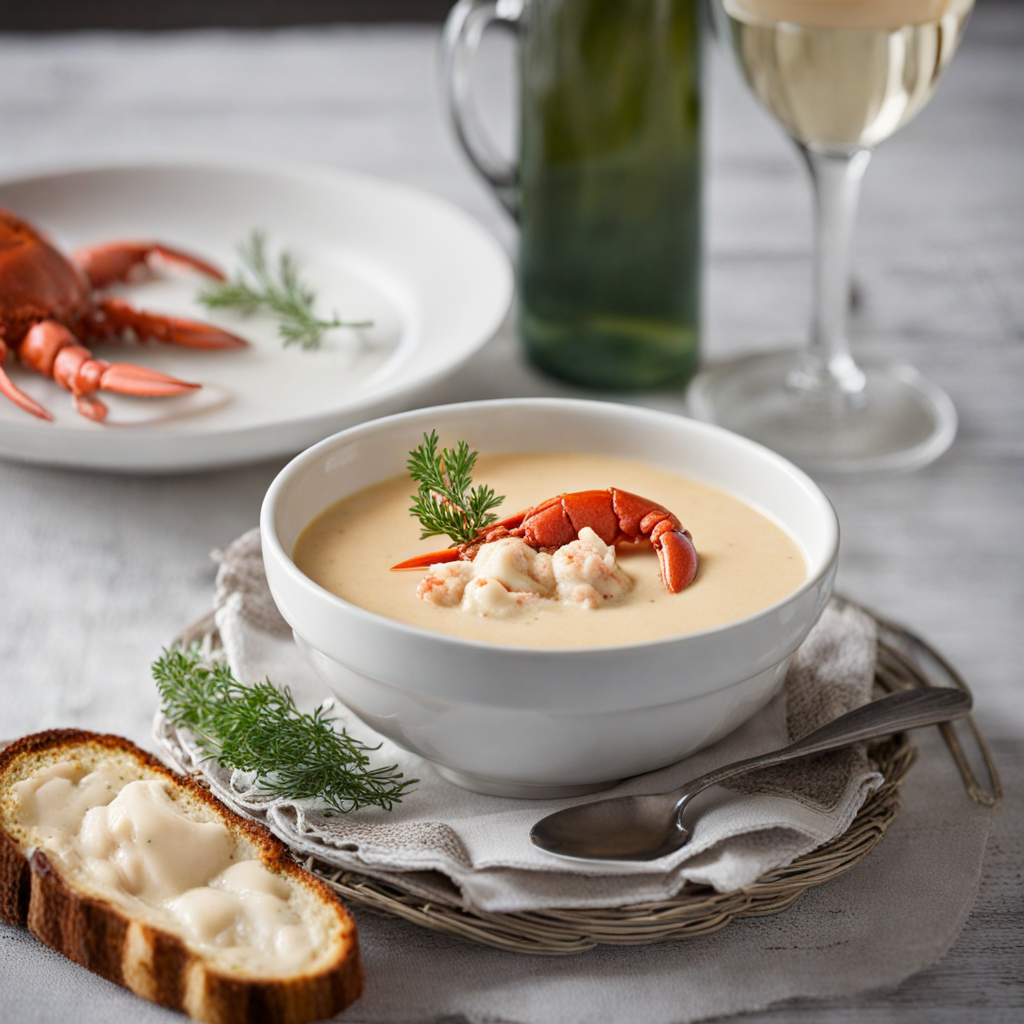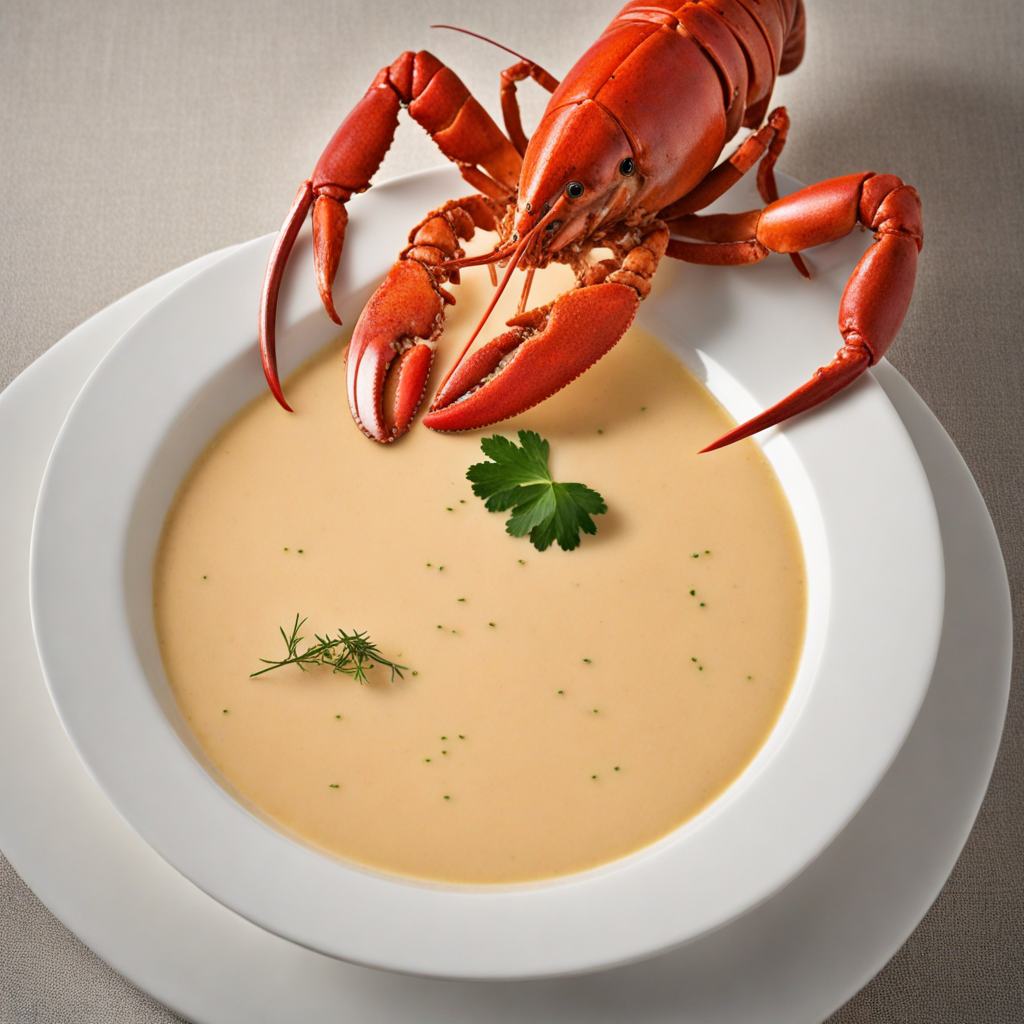Lobster Soup
Lobster Soup is a sumptuous dish hailing from the pristine waters of Iceland, where the ocean's bounty provides the freshest ingredients. This rich, creamy soup typically features succulent chunks of lobster meat, expertly simmered in a velvety broth that blends the sweetness of the sea with earthy undertones. The base is usually made from a combination of lobster stock, cream, and a medley of aromatic vegetables such as onions, leeks, and carrots, which impart a depth of flavor that is both comforting and indulgent. What truly sets Icelandic Lobster Soup apart is the infusion of local herbs and spices, which enhance its natural sweetness. Dill, thyme, and a hint of paprika often find their way into the mix, adding layers of complexity to each spoonful. The soup is typically served warm, allowing the flavors to meld beautifully while providing a cozy warmth that is perfect for the chilly Icelandic climate. This dish is more than just a meal; it's an experience that evokes the rugged beauty of Iceland's coastline. Often accompanied by freshly baked bread, Lobster Soup invites diners to savor the moment as they dip and soak, making every bite a celebration of the ocean's treasures. Whether enjoyed in a quaint seaside restaurant or at home, this delightful dish promises to transport your taste buds to the heart of Iceland's culinary traditions.
How It Became This Dish
Origins of Humarssúpa Humarssúpa, or lobster soup, is a traditional Icelandic dish that showcases the rich marine resources of the North Atlantic. The origins of this delectable soup can be traced back to the coastal communities of Iceland, where seafood has always been a staple of the local diet. Historically, fishing was not only a means of sustenance but also a vital part of Icelandic culture, shaping the nation's culinary practices. The primary ingredient, the Icelandic lobster, is actually a species of langoustine (Nephrops norvegicus), which thrives in the cold, clean waters surrounding the island. Fishermen have harvested this delicacy for centuries, with the practice becoming more prevalent in the 20th century as fishing techniques advanced. The soup itself likely evolved from various regional seafood chowders and bisques, influenced by both local ingredients and international culinary trends, reflecting the melding of Icelandic traditions with external influences over time. \n Cultural Significance Humarssúpa holds a particular cultural significance in Iceland, representing not just the country’s abundant maritime resources but also the communal aspects of Icelandic dining. Traditionally, meals in Iceland are often a time for families and friends to gather, and Humarssúpa has become a favored dish for special occasions and gatherings. The soup symbolizes warmth and hospitality, often served as a starter at festive events, weddings, and holiday celebrations. Beyond its role in communal dining, Humarssúpa also embodies the Icelandic connection to the sea. For centuries, the ocean has been a source of livelihood, identity, and pride for Icelanders. The preparation of Humarssúpa often involves time-honored methods, such as simmering the lobster shells to create a rich, flavorful broth. This practice not only highlights the respect for local ingredients but also reflects the ingenuity of Icelandic cooks who strive to make the most of their resources. \n Development Over Time As Iceland's culinary scene evolved, so too did Humarssúpa. In the mid-20th century, with the rise of tourism and global culinary influences, the dish began to gain popularity beyond the shores of Iceland. Chefs started to experiment with the traditional recipe, introducing new techniques and flavor profiles. This evolution has led to myriad variations, with some modern interpretations incorporating ingredients like coconut milk, ginger, or even saffron, while still retaining the essential essence of the original soup. The globalization of food culture has also influenced how Humarssúpa is marketed and presented. In upscale restaurants, it is often served in refined presentations, with garnishes that elevate the dining experience. This shift has not only helped to redefine the dish as a gourmet offering but also has allowed local chefs to showcase Icelandic seafood on the world stage, thus fostering a renewed appreciation for traditional Icelandic cuisine. \n Global Recognition In recent years, Humarssúpa has gained international recognition, often featured in food blogs, culinary travel shows, and gourmet cookbooks. This newfound fame has contributed to a resurgence of interest in traditional Icelandic foods, as chefs and home cooks alike seek to rediscover and recreate the flavors of their heritage. Food festivals in Iceland frequently highlight Humarssúpa, with competitions and tastings celebrating the dish's rich flavors and diverse interpretations. The increasing popularity of Icelandic cuisine, bolstered by the global trend towards sustainable and locally sourced ingredients, has further solidified Humarssúpa's status as a key representative of Icelandic gastronomy. The dish serves as a prime example of how traditional foods can evolve while remaining rooted in cultural identity. \n Modern-Day Interpretations Today, Humarssúpa can be found in various forms throughout Iceland, from rustic family kitchens to high-end restaurants. While the classic recipe typically features a creamy base, fresh herbs, and chunks of tender lobster, many chefs have adapted the soup to cater to contemporary palates. Some versions incorporate a variety of seafood, such as scallops or shrimp, while others may focus on a more plant-based approach, using root vegetables and herbs to create a lighter broth. Additionally, the use of local ingredients, such as Icelandic dairy and fresh herbs, has become a hallmark of modern Humarssúpa recipes. This emphasis on quality and locality not only enhances the flavor but also supports the Icelandic economy and promotes sustainable practices within the fishing industry. As a result, the dish is now celebrated not just for its taste but also for its contribution to environmental stewardship. \n Humarssúpa in the Future As Iceland continues to navigate the complexities of globalization, climate change, and cultural preservation, Humarssúpa stands as a testament to the resilience and adaptability of Icelandic cuisine. The future of this iconic dish is likely to involve a blend of traditional techniques and modern innovations, ensuring that it remains relevant in an ever-changing culinary landscape. Moreover, as more people become interested in sustainable food practices, Humarssúpa may serve as an example of how traditional dishes can be both delicious and environmentally responsible. By promoting the use of local ingredients and sustainable fishing practices, the soup symbolizes a commitment to preserving Iceland’s culinary heritage while adapting to the needs of contemporary society. \n In summary, Humarssúpa is more than just a comforting seafood soup; it is a reflection of Iceland's rich maritime culture, communal dining traditions, and the evolution of its culinary landscape. As it continues to adapt and thrive in modern cuisine, Humarssúpa remains a cherished dish that embodies the spirit and flavors of Iceland.
You may like
Discover local flavors from Iceland







